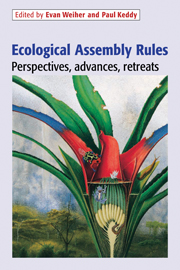Book contents
- Frontmatter
- Contents
- List of Contributors
- Introduction: The scope and goals of research on assembly rules
- Part I The search for meaningful patterns in species assemblages
- Part II Other perspectives on community assembly
- 8 On the nature of the assembly trajectory
- 9 Assembly rules as general constraints on community composition
- 10 A species-based, hierarchical model of island biogeography
- 11 Interaction of physical and biological processes in the assembly of stream fish communities
- 12 Functional implications of trait–environment linkages in plant communities
- 13 When does restoration succeed?
- 14 Epilogue: From global exploration to community assembly
- Index
13 - When does restoration succeed?
Published online by Cambridge University Press: 04 September 2009
- Frontmatter
- Contents
- List of Contributors
- Introduction: The scope and goals of research on assembly rules
- Part I The search for meaningful patterns in species assemblages
- Part II Other perspectives on community assembly
- 8 On the nature of the assembly trajectory
- 9 Assembly rules as general constraints on community composition
- 10 A species-based, hierarchical model of island biogeography
- 11 Interaction of physical and biological processes in the assembly of stream fish communities
- 12 Functional implications of trait–environment linkages in plant communities
- 13 When does restoration succeed?
- 14 Epilogue: From global exploration to community assembly
- Index
Summary
Introduction
How effective have efforts been to restore nature? Has anyone ever successfully restored a degraded site, species for species, or function for function? We attempt to answer these key questions of restoration ecology by reviewing 87 published studies. We also try to relate our results to ecological theory, which may strike the reader as overly ambitious. Our ambition stems from prior experience of assembling other scattered and highly subjective descriptions of nature – food webs. On reading these early compilations, many field workers felt (correctly) that they could collect much better data. As a consequence, the quality and quantity of new studies improved (Pimm et al., 1991) and served to refine food web theory considerably.
Obviously, all restoration ecologists wish for more and better data. It is hoped our ideas will suggest specific choices from the bewildering array of observations for them to report. The ecological theories presented here will surely need improvement; indeed, it may be necessary to abandon them completely. Theories improve most when confronted with data, even data as ill-defined as subjective accounts of restoration's successes and failures.
The simplest division in the expressed goals of restoration is between function and structure. By ‘function’ we mean ecosystem processes, such as primary productivity, water purification, soil erosion, and the loss or retention of nutrients. By ‘structure’ we mean measures of species composition. These measures range from a complete list of an area's original inhabitants, to such qualitative terms as ‘wildlife habitat’.
- Type
- Chapter
- Information
- Ecological Assembly RulesPerspectives, Advances, Retreats, pp. 363 - 392Publisher: Cambridge University PressPrint publication year: 1999
- 56
- Cited by



